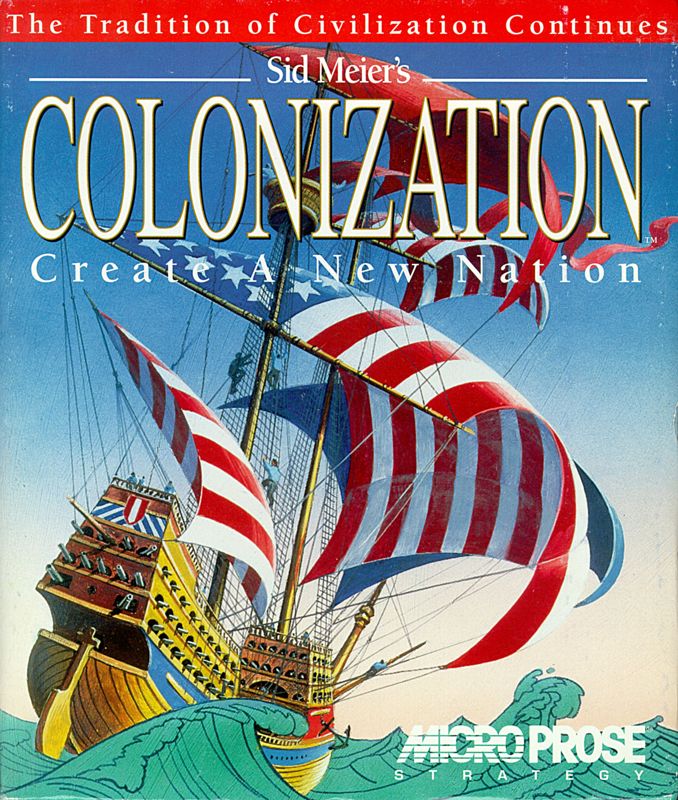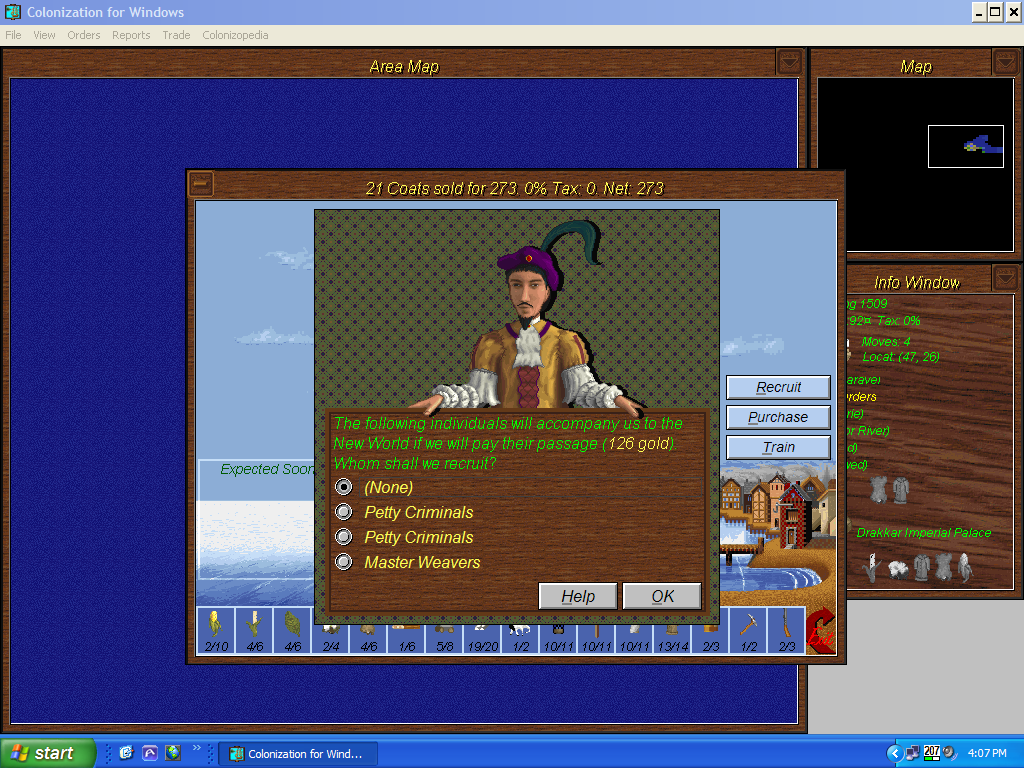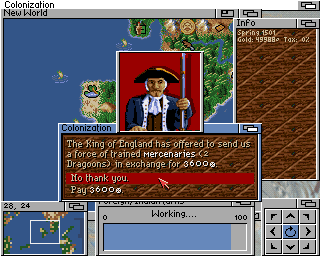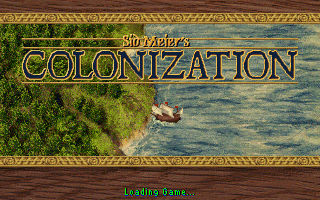Retro Replay Review
Gameplay
Sid Meier’s Colonization excels at presenting a deep, layered strategy experience that unfolds over three centuries of colonial history. From the moment your lone exploration ship sets sail in 1500, you are thrust into a world of uncharted territory where every decision—where to found your first settlement, which resources to prioritize, and how to allocate your manpower—carries weight. The game’s pace invites careful planning: sending out scouts to reveal the coastline and inland terrain, assigning colonists to chop wood or mine ore, and balancing your early exports so you can buy tools, weapons, and additional ships back in Europe.
(HEY YOU!! We hope you enjoy! We try not to run ads. So basically, this is a very expensive hobby running this site. Please consider joining us for updates, forums, and more. Network w/ us to make some cash or friends while retro gaming, and you can win some free retro games for posting. Okay, carry on 👍)
The heart of the gameplay lies in resource management and production chains. Raw materials such as lumber, fur, sugar, and tobacco can either be shipped back to the Old World for profit or transformed into higher-value goods—rum, coats, and other wares—by specialist craftsmen. The presence of “hammers” as a representation of construction speed adds another layer: invest too heavily in exports and you’ll find your colony’s growth stunted; focus on internal production alone and you may miss critical trade opportunities.
Diplomacy and combat weave seamlessly into the economic core. Native American villages offer both opportunity and risk: forging alliances can grant you new professions and maps, while careless trespassing may spark deadly skirmishes. As rival colonial powers close in, you must outfit militias or professional soldiers, deploy artillery in defense of your towns, and even train dragoons for rapid response. The delicate balance between trade, diplomacy, and warfare keeps each session fresh and strategic.
As you progress toward the Revolutionary period, an additional tension emerges in the form of Liberty Bells and escalating colonial unrest. Balancing your King’s demands—often in the form of higher taxes—with your colonists’ desire for independence introduces a compelling endgame dilemma: maintain royal favor and economic stability, or stoke rebellion and risk open war. This evolving political dynamic ensures that no two playthroughs feel the same and rewards those who adapt their strategies on the fly.
Graphics
While Sid Meier’s Colonization debuted in the mid-1990s, its graphics remain charming and functional rather than cutting-edge. The isometric tile-based map clearly distinguishes forests, mountains, rivers, and settlements with clean, colorful sprites. Though pixelated by modern standards, terrain and resource icons are instantly recognizable, aiding in quick decision-making without excessive menu diving.
Animations are straightforward but effective: ships crest waves as they navigate the open sea, caravans trundle along trade routes, and native villages come alive with small details like dancing totems or smoke rising from huts. Battles are represented by simple unit animations and health bars, yet they convey the ebb and flow of skirmishes sufficiently to keep you engaged without requiring minute-to-minute micromanagement.
The user interface emphasizes clarity over flashiness. Menus for assigning colonists, constructing buildings, and negotiating with overseas powers are logically organized, with tooltips that explain each option. Although the UI might feel dated compared to modern grand strategy titles, its responsiveness and lack of clutter mean you spend less time hunting through tabs and more time shaping your colonial empire.
On higher-resolution displays, the game benefits from upscaling and fan patches that sharpen sprites and redraw icons, breathing new life into the visuals. Whether experienced in its original form or with community enhancements, Colonization’s graphics strike a balance between function and historical ambiance, perfectly complementing the gameplay’s depth.
Story
Rather than presenting a rigid narrative, Sid Meier’s Colonization tells a sandbox tale of empire-building that evolves based on your choices. Your personal story as Viceroy begins with a handful of colonists and unfolds through exploration, encounters with native tribes, rivalry with other European powers, and the gradual rise of revolutionary sentiment. Each decision you make—allying with the Iroquois, specializing in rum production, or declaring independence—writes a unique chapter in your colonial saga.
The historical framing from 1500 to roughly 1800 provides authentic context: technological advancements, shifting alliances, and the pressure of royal decrees all shape your journey. The game’s dynamic events—shipwrecks that wash valuable settlers ashore, burial grounds that exact a grim toll on unwary explorers, and treasure troves that could finance your next expedition—lend a sense of discovery and unpredictability to what might otherwise be a purely mechanical process.
Interacting with native populations yields recurring subplots: respected diplomats may win maps and knowledge, while hostile raids can trigger defensive campaigns that test your strategic mettle. Rival European nations similarly play their parts, from sparring over adjacent colonies to launching full-blown invasions when you least expect them. The tension between serving your distant monarch and nurturing colonial autonomy promises a narrative arc that crescendos in the Revolutionary War.
Ultimately, Colonization’s story is emergent rather than authored, but its historical trappings and branching possibilities create a memorable role-playing undercurrent. Whether you end up a benevolent trader, a militant expansionist, or a rebel statesman, your version of the New World will bear the marks of your choices—and that personalized saga is what makes each campaign compelling.
Overall Experience
Sid Meier’s Colonization remains a benchmark in historical strategy and empire-building. Its intricate blend of economics, diplomacy, exploration, and warfare challenges you to think on multiple fronts, rewarding long-term planning and adaptability. Even decades after release, the game’s core systems feel balanced and satisfying, with a learning curve that invites newcomers but offers depth for veterans.
The pacing is deliberate: early exploration and colony setup are suspenseful, mid-game trade and expansion test your resource juggling, and the revolutionary endgame delivers high-stakes drama. Addictive “just one more turn” moments arise when a profitable rum operation hinges on a single cargo ship, or when a cluster of Liberty Bells pushes you to decide the fate of your colonial rebellion.
While its graphics and UI reflect its 1994 origins, fan patches and community mods have kept the experience fresh on modern hardware. Moreover, the absence of a rigid storyline ensures high replayability—selecting different European powers, experimenting with varied production strategies, or pursuing diplomacy over conquest can lead to entirely new outcomes.
For strategy aficionados and history enthusiasts alike, Sid Meier’s Colonization offers an engaging journey through the trials and triumphs of New World empire-building. It may wear its age in pixels, but its gameplay mechanics and emergent storytelling remain timeless, making it a worthy addition to any player’s library.
 Retro Replay Retro Replay gaming reviews, news, emulation, geek stuff and more!
Retro Replay Retro Replay gaming reviews, news, emulation, geek stuff and more!









Reviews
There are no reviews yet.